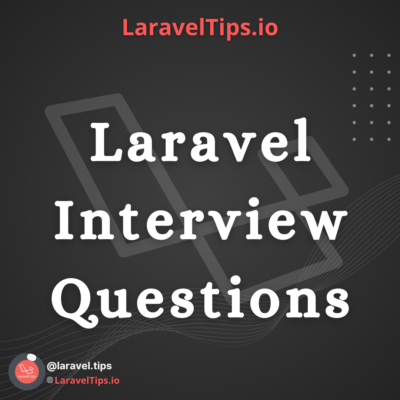Laravel is a popular PHP framework for web development. It is known for its elegant syntax, powerful features, and large community. If you are a Laravel developer, it is important to be prepared for Laravel interview questions.
In this blog post, we will discuss the different types of Laravel interview questions that you can expect, as well as some tips for answering them.
Introduction
Laravel is a free and open-source PHP framework for web applications. It is based on the MVC (Model-View-Controller) architectural pattern and follows the PSR-1 and PSR-2 coding standards. Laravel is known for its elegant syntax, powerful features, and large community.
Laravel is a popular choice for developing web applications of all sizes. It is used by companies such as Nike, Spotify, and The Guardian.
Types of Laravel Interview Questions
Laravel interview questions can be divided into four main categories:
- Core Laravel concepts: These questions test your understanding of the fundamental concepts of Laravel, such as routing, controllers, models, views, and migrations.
- Laravel features: These questions test your knowledge of specific Laravel features, such as Eloquent ORM, Blade templating, and Laravel Mix.
- Laravel development: These questions test your ability to develop Laravel applications, such as creating a new Laravel project, writing a Laravel controller, and deploying a Laravel application to production.
- Laravel troubleshooting: These questions test your ability to troubleshoot Laravel applications, such as fixing a Laravel error or debugging a Laravel application.
Here are some examples of each type of question:
- Core Laravel concepts:
- What is the difference between a route and a controller?
- What is the purpose of a model?
- How do you create a new migration?
- Laravel features:
- What is Eloquent ORM?
- How do you use Blade templating?
- What is Laravel Mix?
- Laravel development:
- How do you create a new Laravel project?
- How do you write a Laravel controller?
- How do you deploy a Laravel application to production?
- Laravel troubleshooting:
- How do you fix a Laravel error?
- How do you debug a Laravel application?
Tips for Answering Laravel Interview Questions
Here are some tips for answering Laravel interview questions:
- Be prepared to answer questions about your Laravel experience. If you have any previous Laravel projects, be sure to mention them in your interview.
- Be familiar with the different types of Laravel interview questions. This will help you to answer questions more confidently.
- Practice answering Laravel interview questions before your interview. This will help you to get comfortable with the format of the questions and to think about how you would answer them.
- Be confident in your answers. Even if you don’t know the answer to a question, don’t be afraid to say so. The interviewer will appreciate your honesty and willingness to learn.
Answering Laravel Interview Questions
Here are some answers to the questions I have mentioned in the introduction:
- What is the difference between a route and a controller?
A route is a URL that maps to a specific controller action. A controller is a PHP class that handles the request for a particular route.
- What is the purpose of a model?
A model is a PHP class that represents a database table. It is used to interact with the database and to store and retrieve data.
- How do you create a new migration?
A migration is a PHP file that is used to create or modify a database table. To create a new migration, you can use the php artisan make:migration command.
- What are the benefits of using Laravel?
Laravel has many benefits, including:
- It is a well-documented framework with a large community of developers.
- It is easy to learn and use.
- It is highly scalable and extensible.
- It is secure and reliable.
- It has a wide range of features, including ORM, templating, and routing.
- What are the limitations of Laravel?
Laravel also has some limitations, such as:
- It can be complex for beginners.
- It can be slow for large applications.
- It is not as flexible as some other frameworks.
- What are some of the best practices for developing Laravel applications?
Some of the best practices for developing Laravel applications include:
- Using a version control system, such as Git.
- Writing unit tests.
- Using a templating engine, such as Blade.
- Using a dependency injection container, such as Laravel’s Service Container.
- Logging errors and exceptions.
- Securing your application.
- How would you compare Laravel to other PHP frameworks?
Laravel is often compared to other PHP frameworks, such as Symfony and CodeIgniter. Here is a table comparing Laravel to Symfony:
| Feature | Laravel | Symfony |
|---|---|---|
| MVC architecture | Yes | Yes |
| ORM | Eloquent | Doctrine |
| Templating engine | Blade | Twig |
| Routing | Laravel’s own routing system | Symfony’s routing system |
| Dependency injection container | Laravel’s Service Container | Symfony’s Service Container |
| Unit testing | Yes | Yes |
| Logging | Yes | Yes |
| Security | Yes | Yes |
Laravel and Symfony are both popular PHP frameworks with a wide range of features. However, Laravel is generally considered to be easier to learn and use, while Symfony is more powerful and flexible.
- What are some of the challenges of developing Laravel applications?
Some of the challenges of developing Laravel applications include:
- The learning curve can be steep for beginners.
- Laravel can be complex for large applications.
- There are a lot of moving parts in Laravel, which can make it difficult to debug.
- Laravel is not as flexible as some other frameworks.
- How would you handle a bug in a Laravel application?
The first step is to identify the bug. Once you have identified the bug, you can try to fix it yourself. If you are unable to fix the bug, you can ask for help from the Laravel community.
- What is Eloquent ORM?
Eloquent ORM is a powerful tool that allows you to interact with your database in a Laravel application. It provides a simple and elegant way to query your database, create and update records, and manage relationships between tables.
- How do you use Blade templating?
Blade is a templating engine that is used in Laravel applications. It allows you to create dynamic and interactive web pages without having to write any JavaScript.
- What is Laravel Mix?
Laravel Mix is a tool that allows you to compile your CSS and JavaScript assets. It also allows you to do things like minify your code and optimize your images.
- How do you create a new Laravel project?
To create a new Laravel project, you can use the composer create-project laravel/laravel my-project command. This will create a new directory called my-project with all the necessary files to get started with Laravel.
- How do you write a Laravel controller?
A controller is a PHP class that handles the requests for a particular route. To write a Laravel controller, you need to create a new file in the app/Http/Controllers directory. The name of the file should match the name of the controller class.
- How do you deploy a Laravel application to production?
To deploy a Laravel application to production, you need to set up a web server and a database. You can also use a cloud hosting service like Heroku or AWS.
- How do you fix a Laravel error?
If you get an error in your Laravel application, you can try to fix it yourself. The first step is to identify the error. Once you have identified the error, you can try to find a solution online or in the Laravel documentation.
- How do you debug a Laravel application?
You can debug a Laravel application by using the built-in debugging tools. These tools allow you to view the values of variables, step through your code line by line, and see the output of each line.
- How would you improve the performance of a Laravel application?
There are a number of ways to improve the performance of a Laravel application. Some of these techniques include:
- Using a caching system to store frequently accessed data.
- Optimizing your database queries.
- Using a CDN to serve static assets.
- Minifying and gzipping your CSS and JavaScript assets.
- How would you secure a Laravel application?
There are a number of ways to secure a Laravel application. Some of these techniques include:
- Using strong passwords and security settings.
- Enabling two-factor authentication.
- Using a firewall to block malicious traffic.
- Encrypting sensitive data.
Conclusion
By following these tips, you can prepare for Laravel interview questions and increase your chances of getting the job.
I hope this blog post has been helpful. If you have any questions, please feel free to leave a comment below.
Here are some additional questions that you might be asked in a Laravel interview:
- What are the benefits of using Laravel?
- What are the limitations of Laravel?
- What are some of the best practices for developing Laravel applications?
- How would you compare Laravel to other PHP frameworks?
- What are some of the challenges of developing Laravel applications?



